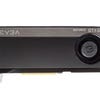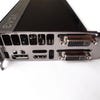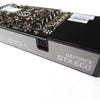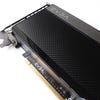NVIDIA GeForce GTX 660 review
Can this sub-?200 Kepler outperform its nearest AMD rivals? Digital Foundry finds out.
It's been a curious year for NVIDIA and its leading Kepler graphics core tech. The spread of the GTX 600 series has been on the patchy side, primarily as a result of lower-than-average yields for the 28nm chips used to make each card. This has meant the company's commitment to the higher-end range has lasted for a longer spell than usual, causing a sore neglect of any real Kepler presence in the middle. The gap remains wide, with the GTX 650 selling as a £90 entry-level solution (which we'll be reviewing in due course) and the next rung up in the series being the GTX 660 Ti at £230. Between the two, something is certainly missing.
This has given rival firm AMD plenty of time to wedge a firm foothold in the popular £100-200 range, with its own Radeon HD 7850 and 7870 cards already making a big splash, at £150 and £180 respectively. NVIDIA's reaction has been methodical, as always; claim the tip-top end with the GTX 680, and then gradually unveil cheaper and progressively cut-down derivatives to fill out the middle range - the GTX 670 and 660 Ti being the first two steps.
The third step has at last landed though, and here we see NVIDIA turn up with its grandest riposte - the GTX 660. On paper, this card offers all the same principle features as the rest of the 600 series, including TXAA support, hardware-based h.264 encoding capabilities, and PCIe 3.0 connectivity. Unlike the Ti version though, this release breaks ground by being the very first Kepler-based card to retail for under £200 - likely to cause plenty of elbow-digging with AMD's 7870 in particular. The gap is slowly but surely being bridged over, but in terms of value and performance, does the 660 hold up?
For our tests, we have a GTX 660 operating with a respectable factory overclock. The reference model weighs in with a core clock of 980MHz, alongside the capacity to boost up to 1033MHz if conditions are cool enough. By comparison, EVGA's "Superclocked" edition bumps this up to 1046MHz, alongside as much as an 1111MHz boost. This should ensure the card has enough processing grunt to compete with the best of them in the series, and the clocks in this version even compare favourably to the GTX 680.
"The new GTX sees CUDA cores and texture units pared back from the 660 Ti, but ROPs, RAM and memory bus remain identical to the more expensive card."
There have been compromises compared to the 660 Ti of course. To compare the specifications directly, we see texture units drop from 112 to 80, and also CUDA cores tucked from 1344 to 960 - though ROPs fortunately remain at 24 apiece. Much like its forebear, the 660 comes configured with up to 2GB of GDDR5 memory, operating at an effective clock of 6008MHz using the very same 192-bit bus.
So how might this compare to AMD's Pitcairn-based cards, the HD 7850 and 7870? Each of these cards ship with lower memory clocks than NVIDIA's latest, and each run at 4800MHz effective. However, bandwidth readings remain superior overall on both AMD cards due to their use of 256-bit buses. This allows for a throughput of up to 153.6GBps, as opposed to the 660's restricted 144.2GBps. Elsewhere, we see the 7870 take charge with 32 ROPS and a base core clock of 1100MHz - locked in place due to the absence of any adaptive boost feature. In terms of the outlook on paper, this is set to be a hard-fought battle.
Physically, our overclocked 660 abandons the Twin Frozr fan setup popularised by many third-party vendors, and instead offers a fully-enclosed plastic case to shield its single fan. It's strikingly similar to the reference card, though the faux-aluminium stripe and checkered texturing to the front panel helps distinguish it from the competing roster. We've often criticised the open-shell cards for feeling too flexible during installation, but build quality here is reassuringly robust. Measuring in at 241mm, the 660 also holds up well compared to the 660 Ti's length of 267mm.
The card comes complete with all the connection standards common to the GTX 660 Ti; a dual link DVI-D being positioned above a DVI-I connection, with HDMI and DisplayPort 2.1 outputs to their right side. Four monitors can potentially run simultaneously through this setup, just as with the preceding cards - though power ratings have changed. The TDP for the card is listed at 140W, the lowest of all tested here, which draws its juice through just a single 6-pin PCIe power connector. It's rare that power usage will ever reach this peak value however, and the box requirements state the card requires just 24 amps off a single +12v rail on a PSU to run.
In terms of heat output, we manage to get the card up to a maximum reading of 69 degrees Celsius during a prolonged stress test with the Metro 2033 benchmark - a healthy number that demonstrates that the factory overclock hasn't overextended itself. Alas, we do notice the return of a faint whirr, comparable to the GTX 670's after long periods of gaming. This is only marginally louder than the 660 Ti's sound signature, which benefits from a more elaborate dual-fan cooling system, though in practice won't bother most.
GeForce GTX 660: Performance Analysis
In terms of performance, the 7870 is already an established force to be reckoned with in the £180 bracket, having shown a convincing command over our benchmark tests - though surprisingly less so with 3DMark 11's synthetic tests. Here we see how the up-and-coming 660 tackles the likes of Batman: Arkham City and Metro 2033, plus the nefariously resource-greedy extreme presets on 3Dmark 11.
"A limited benchmarking run very much suggests that NVIDIA has got a real fight on its hands - the Radeon HD 7870 is in the same price range and pulls ahead on several metrics."
| HD 7850 | HD 7870 | GTX 660 | GTX 660 Ti | |
|---|---|---|---|---|
| Metro 2033 Average FPS | 23.33 | 27.38 | 25.07 | 25.08 |
| Batman AC Average FPS | 51.00 | 67.00 | 60.00 | 60.00 |
| 3DMark 11 Score | X1647/P5492 | X2180/P6907 | X2294/P6330 | X2894/P8500 |
| 3D Mark 11 Graphics | 1473/5534 | 1983/6798 | 2097/6507 | 2631/8937 |
To get our testing methodology out in the open; each game in runs at 1920x1080. with the DirectX 11 API selected, no v-sync, coupled with very high settings, and high tessellation enabled. In the interest of testing parity, we also disable PhysX features for all cards on each tests, and ensure it uses the very same system each time; a quad-core i5 2500k overclocked to 4.2GHz, working in tandem with 8GB of DDR3 RAM.
The results with Arkham City are immediately striking, considering the £50 disparity between the standard and Ti versions of the 660. At an average of 60FPS, we see harsh peaks and troughs throughout the fly-through of the city that would suggest a very unstable gameplay experience in practise. However, the similarity in figures here points to a common bottleneck in both cards; the bus-restricted memory bandwidth. In using 8x MSAA, any inherent advantage in handling Unreal Engine 3 between the two cards is rendered null, and cut down to the base figure. Meanwhile, the lead in throughput for AMD's 7870 allows for in excess of a 10 per cent boost over both of NVIDIA's offerings.
This trend continues for 4A Games' Metro 2033, where the divide between the two 660s is fractional, owing to the close matching of core and memory clocks. The number of lighting effects, explosions and animated enemies - even in such an enclosed space - causes almost every GPU to chug along with this test, but the 7870 comes closest to averaging out something resembling smoothness. The 2FPS lead will once again have its bearings with the 4x MSAA in effect, where the card's higher ROP count makes throughput for pixel and texel-based operations less of a bottleneck.
To round out, we see the 7870 flounder in predictable style with the synthetic 3DMark tests. The extreme preset is of particular interest, as it shows the 660 nosing ahead of the AMD rival by five per cent in both overall and graphics scores, where tessellated jungle environments and shader-heavy oceanic scenes are the focus. Compared to its older brother, the cut-down 660 only achieves 80 per cent of the 660 Ti's scores here, and the gap widens further for performance tests running at 1280x720. This is the first sign that the cut-backs over the 660 Ti may actually have a tangible effect on gameplay
Gameplay Analysis: Video Benchmarks
Synthetic test results don't necessarily reflect the state of affairs for playing most games of course, which is where our trusty video benchmarks come into play. To give the 660 a proper stretch of its legs, we have it run Crysis 2, Battlefield 3 and The Elder Scrolls V: Skyrim in like-for-like scenarios. This allows us to pick out any of the card's strengths or shortcomings in handling the DirectX 11 effects of the former two, or even the streaming distances of the environments in Bethesda's open-world RPG.
"Our test runs on some of Battlefield 3's most intense campaign areas could provide us with no outright winner here, though the GTX 660 did command a very slight, almost unnoticeable advantage over the HD 7870."
- Alternative Analysis: Battlefield 3 GTX 660 vs. GTX 660 Ti
- Alternative Analysis: Battlefield 3 GTX 660 vs. Radeon HD 7850
DICE has an impeccable handle on multi-thread optimisation, meaning many of the physics and AI tasks should pass through our test rig's CPU with ease. This permits us to concentrate on how the 660 handles effects such as horizon-based ambient occlusion, tessellated characters and environments, and the multiple passes of anti-aliasing on offer.
As with all our tests, we run Battlefield 3 at a full 1920x1080 resolution with ultra settings, and v-sync enabled. We play out the Operation Swordbreaker level in its entirety, where having a squad of highly detailed allies shows the Frostbite 2 engine pushing our PC hard, regardless of which card we have installed. This is uncharacteristic of the campaign mode in general or even multiplayer, since a bulk of later levels encourage more solo-driven play, and avoid these extra elements. Nevertheless, this level makes for a thorough stress test - particularly in leaving the SUV at the start and emerging to a military camp filled with soldiers.
The frame-rate in this opening section, and indeed the later battle sequences in the Iraqi streets, generally wavers around the 45FPS mark on the 660, whereas the 660 Ti can push out up to 10FPS higher in coordinated situations. Dreaming big and targeting 60FPS in this case was always going to be off the cards though, seeing as even the more expensive entries in the GTX series struggle to hold ground here. Instead, the recommendation can go two ways; either customise the ultra preset to drop the included MSAA entirely and maintain a perceptual 60FPS, or maintain image quality and simply cap to 30FPS. Fortunately, even at its worst during battle, the 660 stays above that threshold, making it a viable option.
Comparisons with the 7870 are encouraging, but not outrageously in favour of either side of the tussle. The 660's performance can be entirely identical in scripted sequences, such as the cut-scene involving dragging an ally towards safety using QTEs. In that case, we find the NVIDIA taking a 4FPS lead in spots, though rarely anything that would be detectible if FRAPS were turned off. The tides do turn when shader effects hit the screen at the end of our video, after which buildings on the horizon start crumbling down, but overall the lead generally belongs to the 660, even if it is by a wafer-thin margin.
"On some games, the GTX 660 even manages to compare favourably with the more expensive 660 Ti - but it's safe to say that Crysis 2 is not one of them."
- Alternative Analysis: Crysis 2 GTX 660 vs. GTX 660 Ti
- Alternative Analysis: Crysis 2 GTX 660 vs. Radeon HD 7850
Next up is Crysis 2, which has a history of favouring the higher memory bandwidths on AMD cards due to game's taxing post-processing effects on ultra. Previous comparisons between the 660 Ti and 7870 reveal the worth of a having a wider memory bus and more ROPs - and little has changed in both of these regards for the 660. The 7870 may not have the mettle to take on the 1080p60 standard at the absolute highest settings, but it consistently ousts NVIDIA's latest effort.
The difference can be as pronounced as 12FPS, noticed at one stage when opening the chambers to the next flooded segment of the submarine. Both GPUs struggle to handle the water shaders and liberal use of alpha effects for fire in this section. It also bears mention that the 7850, which retails at around £150 right now, can carry much of the experience at just 4FPS under the 660. If ultra settings are a must, then donning a 30FPS cap will be necessary in either case.
Meanwhile, the 660 Ti's output is undoubtedly smoother at these effects-rich settings, and even in battle can even offer a hint of holding 1080p60. We find that blood splashes and gunfire effects, when close to the enemy, are the biggest culprits of frame-rate drops on the standard 660, which once again puts us at the mercy of the card's pared back CUDA cores and texture units. It's a wide lead in favour of the 660 Ti, where the higher boosted core clocks on the new card show little sign of making an impact.
"Perhaps it's time for a new benchmark - GTX 660, 600 Ti and Radeon HD 7870 all run Skyrim at 1080p on max settings, with only the cheaper 7850 registering any noticeable drop in performance."
- Alternative Analysis: Skyrim GTX 660 vs. GTX 660 Ti
- Alternative Analysis: Skyrim GTX 660 vs. Radeon HD 7850
Out of all three benchmark titles we use, the DirectX 9 driven Skyrim is the one to have faith in when it comes to hitting the 60FPS mark on max settings. The ultra preset comes packaged with an excessive 8x MSAA in this case, with high texture detail and radial blur quality included in the mix. Meanwhile, the fade-in detail for geometry, characters, and foliage are also ratcheted up to 15, and in a bid to squeeze each GPU as much as possible, specularity fade is even modified to a higher custom setting of 20.
The 660 successfully pulls a perceptual 60FPS out of the bag here and at the requisite 1920x1080 resolution too. Drops to 54FPS are infrequent and largely unnoticeable when they do occur halfway through the downhill journey to Helgen village. By comparison, the 7870 and 660 Ti cruise straight to the finish line at the executor's block without so much as a blip, which bodes well for the rest of the game - but the 660's performance is largely comparable. In that same midway section, the 7850 is the only card to show vulnerability in meeting the Creation Engine's demands; at 50FPS, with feedback low enough to create a visible judder on-screen.
Gameplay Analysis: The Best of the Rest
Sometimes the best games aren't the most demanding though, and we can readily jump into a perfectly optimised, full HD, maxed out experience with no hassles. In the cases of Diablo 3 or Portal 2 we can hit some obscenely high levels of feedback when v-sync is disabled, the overhead of which could come in handy for stereoscopic 3D users. Diablo 3 in particular is an odd beast, actively cutting your frame-rate down to 30FPS when v-sync is allowed, should it drop even a frame below 60. This results in some terribly jerky screen motion if there's so much as a stutter, forcing you to play with modest graphical settings to work around this. Not so much a problem for our 660.
Running with AA checked, plus smoothed, high shadow quality enabled drags frame-rates down the furthest typically, but here we see each card holding their own. The 660 Ti storms ahead with over 50 per cent increase in frames per second over the 660, as we travel from New Tristram Town to the first way-point. Meanwhile, comparisons with the 7870 remain close, just as with our Dirt 3 Cross Rally test featuring seven other AI cars, which runs at almost identical average frame-rates. This sees the game set to ultra, with 2x MSAA applied for good measure - as with all other games in this test, if there's the option to do so.
"There appears to be no outright winner in the all-important £150-£200 ballpark - every one of the four cards we covered offers superb performance at each of their respective price-points."
| HD 7850 | HD 7870 | GTX 660 | GTX 660 Ti | |
|---|---|---|---|---|
| Call of Duty: Modern Warfare 3 | 127.9 | 157.6 | 157.4 | 158.3 |
| Diablo 3 | 99.7 | 105.7 | 108.5 | 163.9 |
| DiRT 3 | 90.5 | 109.7 | 109.2 | 122.10 |
| Portal 2 | 188.5 | 247.6 | 240.4 | 259.0 |
| Saints Row: The Third | 40.6 | 41.8 | 50.2 | 54.0 |
| StarCraft 2 | 74.5 | 82.9 | 86.7 | 89.6 |
We also see near-matching numbers crop up with Call of Duty: Modern Warfare 3, where the 1FPS difference between the HD 7870, 660 and 660 Ti indicates a ceiling has been hit with either the card's core clocks, or the PC configuration running each card. A play-through of the Black Tuesday level has the 660 giving enough average frames per second to run effectively on 120Hz monitors, where the dips don't come anywhere close to breaching that threshold.
Interestingly, Saints Row: The Third in DirectX 11 mode represents the widest margin by which the 660 surpasses the 7870. The test runs at ultra settings across the menus, and has us playing through the entire rip-roaring first level, building up to a stand-off with hundreds of armour-clad guards on the city rooftops. The lead here is by a considerable 16 per cent over AMD's card and though it trails the older 660 Ti by 4FPS, the 660's relative performance here is well aligned with its £180 price-tag.
StarCraft 2 stands in as our RTS of choice, and breaks the Blizzard mould by offering two primary rendering options to suit all needs. At low settings, we're looking at a simplified version of the engine that operates with completely revised unit models, essentially no shader effects at play, and static shadows. Running at ultra settings, meanwhile, turns the game into a resource monster - particularly when going into the late-game clashes with maxed out armies. We have everything switched on, including reflection effects for Zerg creep, depth-of-field, and volumetric shading on units, all of which bogs the 660 down when in the thick of it. Both NVIDIA releases trump the performance of AMD's cards here, while the Ti is only a few frames on average ahead of the 660.
NVIDIA GeForce GTX 660: The Digital Foundry Verdict
All in all, the GTX 660 can be had for around the same £180 asking price as a HD 7870, which calls into question that crucial notion of value. On paper, performance should favour the AMD card's higher memory bandwidth and greater quantity of ROPs, but the results can still favour the Kepler card in places. The 660's advantages aren't strictly limited to the 3DMark stress tests where the lead is sizeable; we can also see it manifest in games like Battlefield 3, StarCraft 2 and even Saints Row: The Third at these maxed out settings.
"The days of a new Kepler launch being synonymous with a huge leap in performance seem to be over. The GTX 660 is a great product, but AMD price-drops keep the market highly competitive."
Where the HD 7870 does take a charge though, it does so in a likewise manner, meaning a purchasing decision can ultimately boil down to which games you want to play. Crysis 2 in particular benefits from AMD's faster RAM configuration when utilising the game's built-in AA, with the results demonstrating a clearer gulf in performance. Skyrim benefits from a closer adherence to the 60FPS line too, while some older, DirectX 9 orientated titles appear to favour this card over the 660 by a slight margin. It's not a clear victory overall, but the general rule of thumb is that the 7870, in its current cost-cut state, offers more bang for your buck over a wider breadth of titles.
Comparisons with the GTX 660 Ti also merit mention. It's a £50 difference, and the down-grading of the 660 does have a more comprehensive impact on most games. Those wanting to splash out on something a little more lavish would fast find themselves in 660 Ti territory but for playing games like Skyrim at 60FPS, the addition of the 660 to the mid-range is a welcome one.
Up until now, if you were scouting for a card with staying power on the NVIDIA side, the most economical option would have been to save the pennies for a GTX 670. Now, however, with the simultaneous release of both the GTX 650 and 660, the gap has at last been bridged and there are options aplenty to suit almost every price range - with the notable exception of the lower £100 bracket, which remains unfulfilled. The release of the 660 in particular suits the enthusiast crowd hesitant to upgrade "full-hog" immediately, and who instead might prefer to play on a decent mid-range card until a next-gen standard card lands. In such a case, the 660 comes as a well-rounded recommendation.






